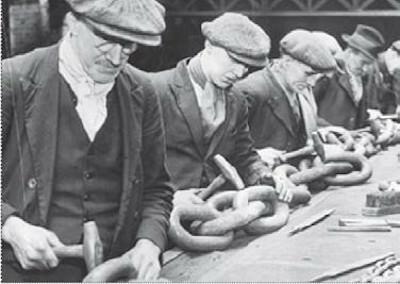O Fordism was an industrial production model that emerged in the United States in the first decade of the 20th century. Its creator was Henry Ford, founder of the car manufacturer that bears his surname and in which he implemented the Fordist logic of production for the first time.
The Ford model introduced the conveyor belt to the assembly line, automating production and changing the pace of work in factories. The workers became permanent, and each of them began to perform a single task on the production line. Fordism was also characterized by standardized and large-scale production, the formation of large stocks and low production costs.
Read too: Industrial Revolution — the changes brought about by the consolidation of industry
Summary about Fordism
Fordism is an industrial production model developed by Henry Ford based on the adaptation of Taylorism for his car manufacturer, Ford.
It was initially implemented in the United States, at the beginning of the 20th century, in context of the Second Industrial Revolution.
Its characteristics were the organization of industrial production through the assembly line equipped with a conveyor belt, standardization of production, large-scale production, and low production and production costs final merchandise.
Workers, in Fordism, specialized in a single function and performed the same task every day on the assembly line. In this sense, there was an alienation of work.
Transformations in work, in the population's way of consuming and in the technical and scientific environment gave rise to a new productive logic in the 1970s, Toyotism, which replaced Fordism.
Video lesson on Fordism
What is Fordism?
Fordism was a industrial production model developed by Henry Ford (1863-1947), at the beginning of the 20th century, through the improvement and adaptation of the model in vogue on the European continent until then, Taylorism. Its implementation initially took place in the United States, at the Ford automobile factory, today one of the main multinational companies in the sector.
What is the origin of Fordism?
The Fordist production model had its origins in a historical context marked by the second phase of the Industrial Revolution, which then expanded to countries such as Japan, Germany and the United States, and by the transformation in the scale of production and the form of consumption of the population in countries where industrialization was present. Meanwhile, in 1909, American engineer and businessman Henry Ford opened his automobile factory in the city of Detroit, located in the US state of Michigan.

Ford was considered the pioneer of the assembly line-based mass production model. His idea came from another existing model that was in vogue in Europe: Taylorism. Taylorism was essentially based on mass production, the rationalization of work and the division of tasks — management functions. What Ford introduced was the automation of the production process through the installation of conveyors, thus creating an assembly line.
Read too: After all, what is the industry?
Main characteristics of Fordism
The main characteristic of the Fordist production model was the automation of the assembly line through the installation of a conveyor belt rolling, whereby products moved within the factory. In the case of Henry Ford, the cars in the assembly process were lined up on the conveyor belt, and, as they moved from one station to another, a new stage of assembly took place. This was the biggest innovation introduced in the industry of that period, meaning that the worker's time was dictated by the machinery, and not the other way around.
Other important characteristics of Fordism they were:
Standardization of raw materials and inputs (such as machines) used in the production process. As a result, there was also the standardization of goods, such as the Ford car known as the Model T, manufactured between the 1910s and 1920s.
Composition of merchandise stocks.
Shorter production time and high productivity guaranteed by the conveyor belt introduced into the assembly line.
High specialization of workers, considering that each individual was in charge of a specific task and carried out repeatedly.
Carrying out quality control as the final stage of production.
Lower price of products to the end consumer, which was due to the reduction in production costs with the new production model.
Changes caused by Fordism
Fordism was responsible for important changes in industrial production at the beginning of the 20th century. The main one, as we discussed in the previous topic, was the adding a conveyor belt in factories. From then on, workers became increasingly specialized in a single function, while not moved within the manufacturing unit to carry out their tasks: it was the product that moved through the new structure.
With Fordism, the mass consumption, In addition to large-scale production, became more present in society, a fact derived from the cheapening of goods. Furthermore, there was also a certain standardization of consumption through supply. It is known that, at the time of the introduction of this new production model, Ford was assembling its Model T, and very few colors were available for the buyer to choose from. Initially, only black models were sold by the automaker.
Read too: Capitalism — economic model that aims for profit and the accumulation of wealth
End of Fordism
Fordism established itself as the main model of industrial production in the first half of the 20th century, but profound geopolitical and economy that took hold in the world from the 1970s onwards culminated in its end and eventual replacement by a productive logic more suited to the new times.
Large-scale production and the creation of stocks, although they were very beneficial at the height of Fordism, resulted in a real overproduction crisis It is on one accelerated increase in costs of the production process, which were no longer supplied by sales. This means that there were a surplus of goods in stock and a lack of people interested in purchasing them, which directly affected the factories' financial return.
The crises of the capitalist system, like the one that happened in 1929, also contributed to the decline of Fordism over time. Added to this are the demands for a greater diversity of products on the market and the issues linked tos conditionions of work in industries who used this production model. They were very tiring and alienating journeys, as the employee repeated the same function all the time, in addition to the work rhythm being driven by the treadmill. This fact was the target of much criticism, one of the most famous in film form: Times mmodern (1936), by Charles Chaplin.

The 1960s and 1970s represented a profound change in the global technical and scientific environment with the advent of new information and communication technologies, characterizing globalization. Capitalism entered its monopolistic phase, and transnational companies gained more and more space with the flexibility of production. This period therefore marked the end of Fordism and the advent of Toyotism as the main model of industrial production.
What are the differences between Fordism, Taylorism and Toyotism?
See the table below for main differences between the Fordist, Taylorist and Toyotist production models. It is important to point out that Taylorism and Fordism were developed between the 19th century and the first half of the 20th century, while Toyotism developed from the 1950s onwards and reflected the characteristic transformations of the current phase of capitalism and of technical and scientific.
Fordism |
Taylorism |
Toyotism |
Mass production. |
Mass production. |
Production carried out in batches, according to demand. |
Formation of large stocks. |
Formation of large stocks. |
Lack of stocks with immediate dispatch of production (system just in time). |
Production time is dictated by the industrial conveyors, that is, by the machine. |
Production time depends on the performance and income of each worker. |
Production time depends on the demand for the merchandise. |
Workers perform a single function. |
Workers perform a single function. |
Workers perform various tasks and functions, and work groups are formed if necessary. |
Quality control carried out at the end of production. |
Quality control carried out at the end of production. |
Quality control carried out during all stages of production. |
Solved exercises on Fordism
Question 1(Enem) In the image from the beginning of the 20th century, a production model can be identified whose form of factory organization was based on:

a) autonomy of the direct producer.
b) adoption of the sexual division of labor.
c) exploitation of repetitive work.
d) use of qualified employees.
e) encouraging employee creativity.
Resolution: Alternative C
The image depicts a production line characteristic of Fordism, a system in which work was based on the repetition of tasks.
Question 2
(Unicentro) Fordism had its origins in the United States, created by Henry Ford, who implemented the production line to manufacture the T car model. This model of work organization limited workers to carrying out repetitive activities throughout their working day.

Regarding Fordism, it is correct to say:
a) Its main objective is to reduce the cost of production, and the consequent reduction in the monetary value of the product, and greater commercialization.
b) The worker has knowledge of the entire production line process.
c) Workers' health is carefully monitored, with the use of workplace gymnastics, aiming to reduce repetitive strain injuries.
d) This process brought benefits to the business class and the working class.
e) Currently, the production line model has been supplanted, and the automobile industries have come to consider the assembly line obsolete.
Resolution: Alternative A
The productive logic of Fordism aimed to reduce production costs, which reduced the price of final products and facilitated the consumption of these goods, thus generating consumption in pasta.
Image credits
[1] Grzegorz Czapski / Shutterstock


